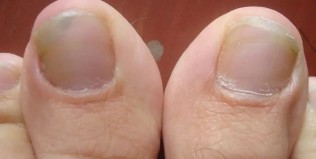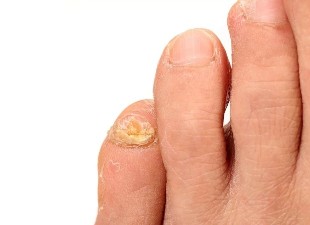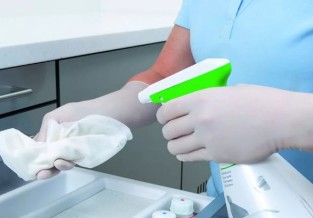There is hardly a man, never heard of such a pathology, like a sponge. Someone who is familiar with the diagnosis of ad pharmacological means, and someone learned about the disease first-hand, when he came out of the doctor's office a dermatologist or by its using of diagnosis.

Definition
The medical term onychomycosis (lat. onychomycosis), in translation from Latin means nail fungus, and serve a designation of infectious diseases of a fungal nature. It is the most common in the world of the defeat of the nail plate and with the fitting to her of the soft tissues: according to statistics of the world health organization (WHO) mycosis of the feet affects approximately 27 % of people, while this indicator almost twice the number of fungal infections of the nails on the fingers.
Types of fungal nail disease
Onychomycosis adopted classified according to the appearance of the affected places. Because the classification of a sign is how it looks like fungus on the nails, it changes from three types, depending on the clinical manifestations:
- atrophic, or onycholitic – in which will nail plate develop a yellowish affected significantly, up to the point of rejection from the nail bed;
- hypertrophic view, which lost the natural shine of the nail changes its color (white or, on the contrary, it darkens) and structure (tangible thickens) with the appearance of different kinds of tension and even destroyed at the edges;
- normotroficheskie – type, characterized by a very low degree of lesions in which will nail plate develop a yellowish is not thickened, it will remain shiny and smooth, but yet outwardly transformed by appearing on her spots, stripes and other visible changes to its natural transparency and colour.
There is another classification, according to which the sponge on the nails are divided into types depending on the specific location of the lesion:
- the absolute, in which the pathogenic process is covered by a whole will be a nail plate develop a yellowish;
- distal – a form of defeat, only to the free edge of the nail, acting over the pad of your finger;
- the proximal, which is destroyed by the edge of the plate, out from under the nails of the roller (opposite to the free edge of the nail!);
- side form of slaughter, topics that relate to the side of the nail plate.

What looks like pathology
The most common among the population of fungal nail disease have external similarity with other dermatological disease is not a fungal nature. Depending on the degree of pathology, the nails begin to look unhealthy, because they lose their natural shine and transparency.
From the smooth and smooth, becoming thick and deformed, and are covered by different colors (most often white or almost yellow) tinge. Soft tissue, destructible parasite keratin layer is also involved in the inflammatory response, swelling.
If we consider the image of the destruction of the nail plate in the preview on the dynamics of the disease, its can be divided into three consecutive phases:
- On the first stage with virtually no symptoms, in addition to easy to tarnish, dots or stripes on the plate.
- On the so-called significant stage, quickly changing the initial, the whole symptoms of onychomycosis becomes more apparent.
- Launched phase – it's marginal degeneration of the nail, may be the emergence of the odor of decomposing tissue.
Symptoms of fungus on nails
The occurrence of symptoms of mycosis match the conventional chronology of the development of the pathogenic process, the rate of which depends both on the specific type of pathogen, as well as from the individual characteristics of the health status of ill.
So, how to identify fungus on the nails before the visit to the cabinet of dermatologist? Take a closer look at the characteristic symptoms, accompanying fungal defeat of the nail plate on the fingers:
- First nail the boards to lose their shiny luster, become dull and lumpy.
- Then from transparent and pink, the nails change color, becoming whitish, gray or dirty-yellow.
- The thickness of the sheet increases.
- On the surface of the body appear defects in the form of stripes, waves, warping, bends and so on
- The nail will appear brittle, begins to peel off and falling apart.
- Fingers due to the increase in inflammatory processes begin to emit an unpleasant odor.

After all, it is completely ruined nails exposed onycholysis, i.e. flaking, revealing pringtime bed.
The reasons for onychomycosis
Pathology is one of the manifestations of the mycosis, representing the us defeat in this case, the nail plate micro-organisms-the dermatophytes of one (or several!) of the three genera:
- Microsporum (a type of canis);
- Trichophyton (species rubrum – 90% of all fungal infections, mentagrophytes, interdigitale, and tonsurans) – the most commonly found pathogens of fungal infections;
- Epidermophyton (kind floccosum).
Representatives of all three clans, united general title of "nail fungus", when ingested, colonise (i.e., localized) Horny derivative of the epidermis of the skin:
- nails;
- hair.
The reason why such a selectivity of the location of the micro-parasites lies in their diet: all representatives as a source of energy used by fibrillar protein keratin, destroying nails and hair.
Methods of infection
All kinds of pathogens transmitted by contact:
- physical contact from an infected person to a healthy;
- through things, contact with the affected parts of the body (shoes, personal objects, and so on).
Contact with the nails or the skin, which has become a place of habitat of the parasite, allowing the living representatives of the mold to get to the healthy part of the body.
In this case, in order to pathogen of onychomycosis fulfilled infiltration in human tissue, requires such conditions as:
- damage to skin integrity sheets (dermatitis, diaper rash, vascular and skin diseases, abrasions, pain, etc.);
- weakened immunity;
- the presence of associated diseases (genodermatosis and hemolytic disease, immune and endocrine disorders);
- intake of cytotoxic and hormonal drugs, as well as antibiotics.

In connection with the entry of the parasite into the body of a healthy person is not in all without exception cases, result in the clinical manifestations of the disease, or only very weakly expressed forms of pathology.
Due to certain individual conditions which they contain, and a strong immune protection, the people residing on the outside healthy, it becomes a carrier of the parasite, infecting other people.
How to recognize the disease
Because of the external similarity of the mycotic lesions with mechanical deformation and the symptoms of other diseases of the nail plate, on the basis of the clinical diagnosis involves not only the external characters — looks like a sponge — and more and supplementing their results of micro-studies.
For laboratory analysis are used different sections of the affected nail, producing a scraping for fungus of the nails with special tools.
The specific type of parasite detected using the two most appropriate research:
- culture, through the facilities of the biological sample of the affected tissue on a special breeding;
- molecular-biological methods or the so-called polymerase chain reaction (PCR).
More accurate and more informative DNA-diagnostics are not yet sufficiently widespread.
In response to the question: "how to recognize nail fungus at home", experienced dermatologists will recommend all the same, consult an expert to conduct a comprehensive, and in necessary cases, and differential diagnosis.
What is dangerous nail fungus
Uncomplicated nail fungus symptoms, although unpleasant, but the traditional mycoses: a bundle of nails, pain sensations, etc.
But in some cases the mycotic can connect, for example, a bacterial infection or disease can be acute, with the emergence of blisters, ulceration, weeping land on the surrounding soft tissues.
Happens, drug therapy, long performed outpatient (more than 16 weeks!), it is not clear, and the disease progresses.
What is dangerous nail fungus, after a long period of time is not amenable to treatment? In the inflammatory process to involve the authorities and their systems, and then may require emergency hospitalization of the patient.
Methods of treatment of fungus on nails
In the early stages of the disease official medicine holds conservative methods, through the determination of the pharmacological treatment.
Anti-mycotic preparations intended to destroy the fungus under the nail, contain substances that are capable of actively oppress the livelihood of its various stamps. To achieve effective therapy can be used various pharmacological forms, sometimes directors comprehensively:
- tablets — for the production of the administered orally (through the gastrointestinal tract, usually washed down with water), prescribe in the absence of the desired effect of the external medicines;
- ointments, pastes and gels for local, outdoor use, using the product directly on the affected parasite part of the body;
- spray;
- solutions (resorcinol, boric acid, brilliant green, etc.) and suspension, for patches impregnated with the means of napkins to the affected area, or the use of the drug in the form of medicinal baths.
Products external use use it usually twice a day, and up to the authorisation of the clinical manifestations. In the case of significant keratosis to facilitate the penetration of the dosage form deep into the keratin of education shall carry out its partial separation. If the symptoms of nail fungus is indicative of the accession of secondary bacterial infection, patients recommended combination of antibiotics.
Important! If you have resorted to systemic Anti-mycotic agents, control of possible functional disorders of the necessarily produce the biochemical study of the liver (analysis of blood serum for the presence of bilirubin, the presence of the enzyme aspartate aminotransferase, gamma-glutamyltransferase increased, etc.
If the patient, the attending, for example, a nail fungus on his thumb, suddenly appears a sharp inflammatory processes and/or with a strong itching, resorted to the means:
- antihistaminicas (from edema and inflammation);
- desensitize (which are deductible sensitivity).

Therapy by pharmacological means, as a rule, is a year-round and lasts a long time – not less than three months!
This duration of treatment is explained by the introduction of the pathogen into the structure of the nail, in relation to what needs time to update, with a gradual consistent circumcision of the land. In the case that the disease is at a stage when the treatment of treatment does not give positive results (total form), or patient – a person senile age, resort to the radical methods, is removed surgically destroyed the parasite nails.
Prevention
The best treatment – it is a preventive action to prevent the disease, it is much easier than the first to settle the fungus on the nail, and then get rid of him. Good ways to prevent the infection operates the strict observance of rules of personal hygiene, especially in public places, the danger is that the potential contact with native speakers of the mycosis, as well as prevention:
- primary, in the form of exceptions to the abnormal dryness of the skin, abrasion, trauma and excessive sweating, and in case of their occurrence – early treatment of, e.g., aluminium hydrochloride 15% with ditilinom glycol 1% in increased sweating of the feet;
- secondary – disinfection special solutions objects contact with fire pit mycosis (shoes, towel, etc.).
They have the right information, from which appears the fungus on the nails, it is quite possible to secure yourself and your loved ones from infections and if the disease is early and adequate therapy are able to speed up the recovery.





























